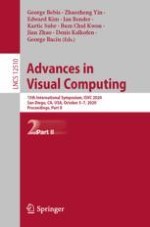This two-volume set of LNCS 12509 and 12510 constitutes the refereed proceedings of the 15th International Symposium on Visual Computing, ISVC 2020, which was supposed to be held in San Diego, CA, USA in October 2020, took place virtually instead due to the COVID-19 pandemic.
The 118 papers presented in these volumes were carefully reviewed and selected from 175 submissions. The papers are organized into the following topical sections:
Part I: deep learning; segmentation; visualization; video analysis and event recognition; ST: computational bioimaging; applications; biometrics; motion and tracking; computer graphics; virtual reality; and ST: computer vision advances in geo-spatial applications and remote sensing
Part II: object recognition/detection/categorization; 3D reconstruction; medical image analysis; vision for robotics; statistical pattern recognition; posters
